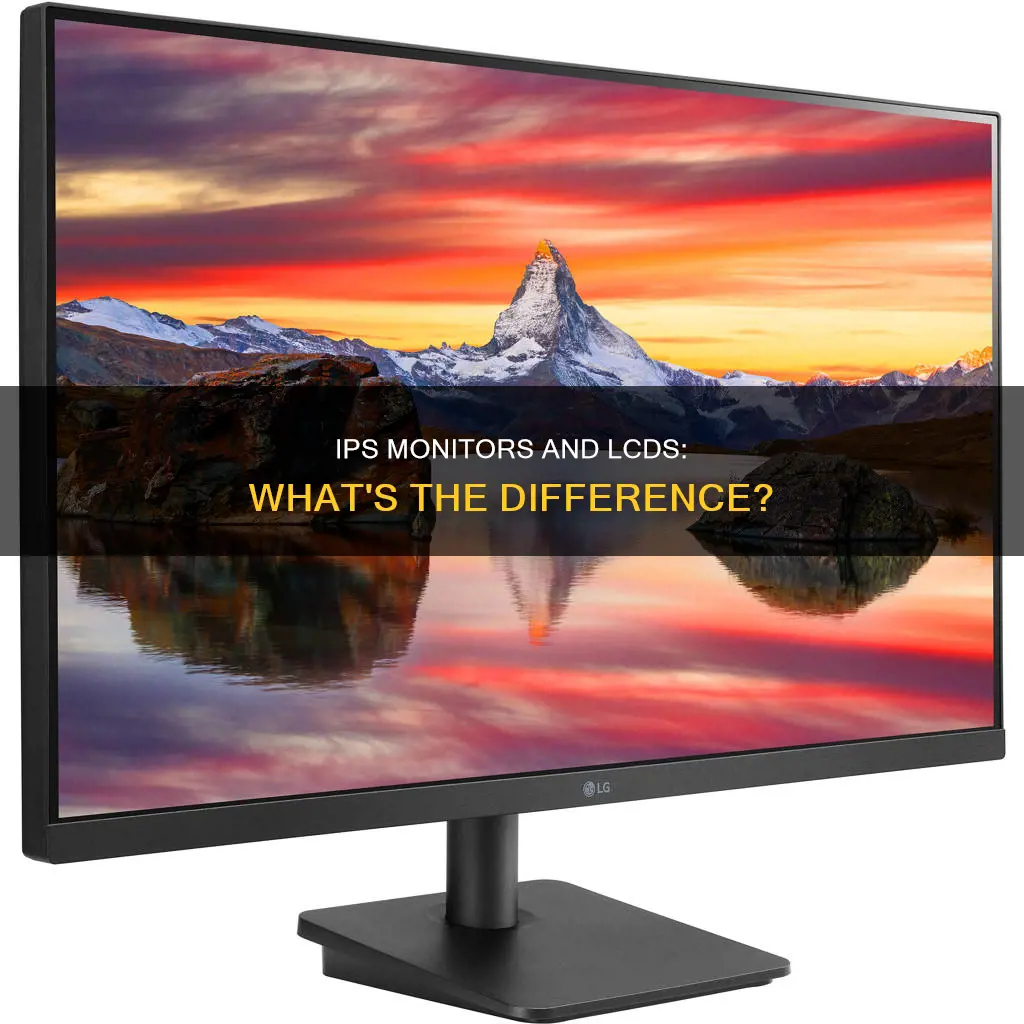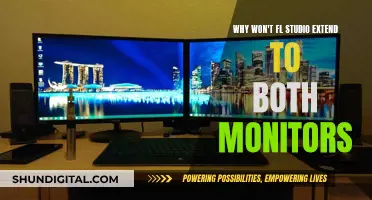
IPS (in-plane switching) is a type of LCD (liquid crystal display) screen technology. It was designed to improve the viewing angle and colour reproduction of the TN (twisted nematic) matrix LCDs that were common in the 1980s. IPS screens are known for their colour accuracy, wide viewing angles, and consistent image quality. They are commonly used in TVs, tablet computers, and smartphones.
What You'll Learn

IPS vs TN and VA panels
IPS (In-Plane Switching) monitors are a type of LCD display panel technology, and are considered the gold standard for photo editing and colour-critical pro uses. They are known for their excellent colour accuracy and consistency, as well as their wide viewing angles.
TN (Twisted Nematic) panels are the oldest type of LCD screens, and are the most widely produced. They are popular with competitive gamers as they have the fastest response times and the fastest refresh rates on the market. However, they have the poorest colour accuracy and contrast ratio of the three types.
VA (Vertical Alignment) panels are considered the sweet spot between IPS and TN. They are widely used for flat-screen TVs and are great for blocking out backlight, ensuring better uniformity in contrast ratios and black levels. They have a slower response time than IPS and TN panels, making them a poor choice for gaming.
IPS panels are the most expensive of the three, followed by VA, and then TN, which is the cheapest.
Choosing the Right Monitor Size for Solidworks Users
You may want to see also

IPS technology
IPS stands for in-plane switching, a type of LED (a form of LCD) display panel technology. IPS panels are known for their impressive colour accuracy and viewing angles, which are considered the best among the other main types of display panels, TN (twisted nematic) and VA (vertical alignment).
IPS monitors were designed to overcome the limitations of TN panels, specifically addressing the issues of viewing angle dependence and low-quality colour reproduction. The liquid crystal's ability to shift horizontally allows for better viewing angles, and the IPS monitor has a very good viewing angle performance. The four axial directions of up, down, left, and right can achieve a viewing angle close to 180 degrees, which is better than that of the LED monitor.
IPS panels are defined by the shifting patterns of their liquid crystals. The technology changes the arrangement of liquid crystal molecular particles and adopts horizontal conversion technology. The liquid crystal molecules rotate and move in the plane, and are reoriented by an applied electric field, while remaining essentially parallel to the surfaces to produce an image.
IPS monitors continue to be the display technology of choice for users that want colour accuracy and consistency. They are widely used in panels for TVs, tablet computers, and smartphones. IPS panels are also used in touch-screen devices, such as smartphones and tablet computers, as they do not lighten or show tailing when touched.
IPS panels have some disadvantages. They are more expensive to produce than TN and VA panels, and they require more power. Response times are also slightly longer than TN panels, and IPS panels are sometimes vulnerable to a defect called backlight bleeding.
Monitoring Data Usage: Tracfone's Easy Steps to Track
You may want to see also

LCD technology
LCD stands for Liquid Crystal Display. LCDs are a type of flat-panel display that uses liquid crystals in its primary form of operation. They are commonly found in smartphones, televisions, computer monitors, and instrument panels. LCDs are thinner, lighter, and more energy-efficient than cathode ray tube (CRT) technology.
LCDs work on the principle of blocking light rather than emitting it. They use liquid crystals to produce an image using a backlight. The liquid crystals in an LCD can be electronically switched on and off, and they rotate polarized light. A polarizing glass filter is placed in front and behind all the pixels, with the front filter placed at 90 degrees to the back filter. The liquid crystals are in between these filters and can be switched on and off using electricity.
LCDs are made with either a passive matrix or an active matrix display grid. The active matrix LCD, also known as a thin-film transistor (TFT) display, has a transistor located at each pixel intersection. This requires less current to control the luminance of a pixel and allows for more frequent switching, improving the screen refresh time.
The passive matrix LCD, on the other hand, has a grid of conductors with pixels located at each intersection. A current is sent across two conductors on the grid to control the light for any pixel. While this system is simpler, it has slower response times and imprecise voltage control, leading to fuzzy images and a lack of contrast.
LCDs have several types, including Twisted Nematic (TN), In-Panel Switching displays (IPS panels), Vertical Alignment Panels (VA panels), and Advanced Fringe Field Switching (AFFS). IPS panels offer better contrast ratios, viewing angles, and color contrast when compared to TN LCDs. VA panels are of medium quality between TN and IPS displays, while AFFS panels are top performers in color reproduction range.
Monitoring Resource Usage: Strategies for Efficient Startup Management
You may want to see also

IPS display advantages
IPS (in-plane switching) monitors are a type of LED display panel technology and part of the LCD family. They offer several advantages over other display technologies, particularly in terms of colour accuracy, viewing angles, and outdoor visibility. Here are the key advantages of IPS display panels:
Outstanding Colour Accuracy and Consistency
IPS monitors are known for their superior colour accuracy and consistency compared to other display technologies. They offer a wider colour gamut, with IPS panels typically having an 8-bit RGB colour depth that can reproduce approximately 16.7 million colours. Some manufacturers even offer 16-bit and 24-bit models, which can display hundreds of trillions of colours. This expanded colour depth improves colour accuracy and overall image quality, resulting in a better viewing experience.
Super-Wide Viewing Angles
Another advantage of IPS panels is their super-wide viewing angles, typically offering 178-degree vertical and horizontal viewing angles. This means that colours and image quality remain consistent even when viewed from extreme angles. In comparison, other display technologies like TN (twisted nematic) panels suffer from limited viewing angles and colour shifts when viewed from different angles.
Superior Image Quality for Professionals
The combination of excellent colour accuracy and wide viewing angles makes IPS monitors ideal for professionals in fields such as graphic design, photography, and video editing. IPS monitors support professional colour spaces like Adobe RGB, delivering the colour accuracy and consistency required by these industries.
Improved Outdoor Visibility
IPS panels also offer improved visibility under bright outdoor lights or direct sunlight compared to other display technologies. This advantage is due to the backlighting used in IPS panels, which makes colours and images more visible in outdoor conditions.
Faster Response Times
IPS monitors have made significant improvements in response times, now offering speeds sufficient for most users, including gamers. While IPS panels were initially criticised for slow response times, technological advancements have addressed this issue, making them more versatile for various applications.
While IPS displays offer these advantages, it's important to note that they may also have drawbacks, such as a limited contrast ratio, inefficient power consumption, and higher production costs. The choice between IPS and other display technologies ultimately depends on the specific requirements of the user.
Setting Up Audio on Your ASUS XG35VQ Monitor
You may want to see also

IPS display disadvantages
IPS (In-Plane Switching) is a type of LED display panel technology, and a form of LCD. IPS monitors are known for their great image quality, with vibrant and realistic colours, and ultra-wide viewing angles. However, there are some disadvantages to IPS displays:
Slow Response Times
IPS monitors have slower response times than TN panels, which can result in motion blur and ghosting effects. This makes them less suitable for fast-paced applications, such as competitive gaming.
High Power Consumption
IPS panels consume more power than TN panels, making them less suitable for battery-operated devices. They require strong backlighting to make the colours and images visible, which contributes to their higher power draw.
High Production Costs
IPS panels are more complex to manufacture, which results in higher prices for consumers. IPS monitors are therefore more expensive than TN panels.
Poor Contrast Ratio
IPS panels have a better contrast ratio than TN panels, but when compared to VA panels, they fall short. VA panels can block backlighting more effectively, resulting in deeper blacks, brighter whites, and an overall higher contrast ratio.
Potential Colour Degradation
While IPS panels offer improved colour accuracy and viewing angles compared to TN panels, they may still experience some colour degradation when viewed from certain angles. This is more noticeable when compared to VA panels, which have even wider viewing angles and minimal colour shifts.
ASUS 144Hz Monitors: Best Gaming Displays for Competitive Players
You may want to see also







